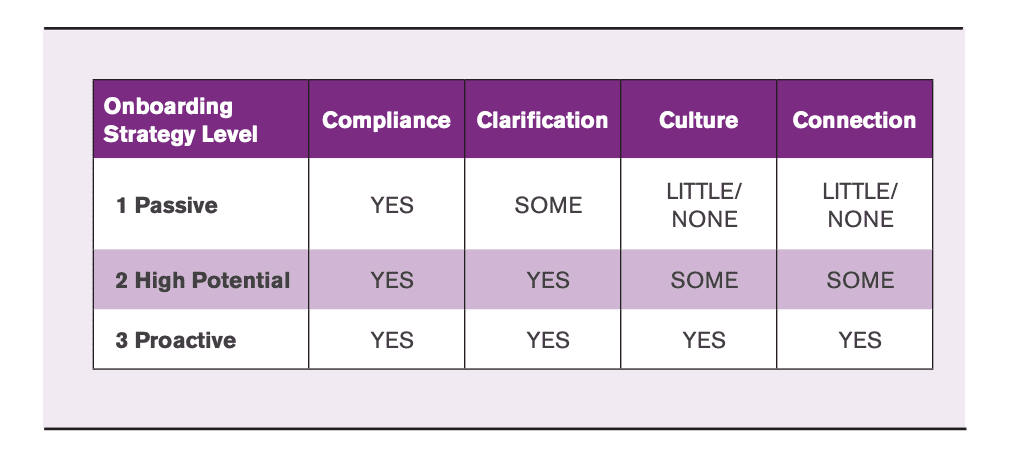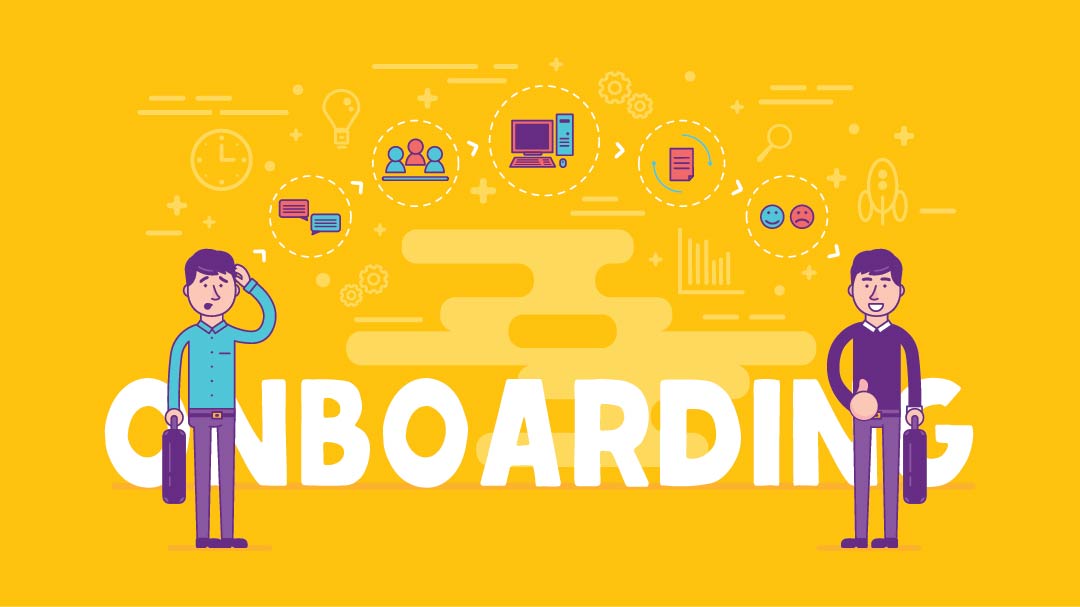After countless rounds of interviews, you have finally found the perfect candidate for the key role you needed to fill in your organization. You want them to love your business as much as you do and to meet productivity goals as soon as possible. To meet both goals, you need an employee onboarding plan.
If you invest in a comprehensive onboarding plan, other benefits you are likely to see are:
- Decreased employee turnover
- Increased employee satisfaction
- Understanding of job expectations and goals
- Shorter ramp time to job proficiency
All of these benefits contribute to internal efficiency, lead to better customer service and lower costs.
Think of your employee onboarding plan as your first chance to make a good impression for new hires. Alongside new hire training, an effective program shows you take their readiness seriously and that you are committed to helping them succeed from day one. The purpose of this article is to identify key elements of successful onboarding plans that you should consider when setting up your own and resources to help you get started.
Onboarding vs. Orientation
Where orientation sessions may last an hour or a day, an onboarding plan can last up to six months to a year or longer, depending on your organization and the employee’s learning curve. Orientation programs are typically generalized to accommodate a large number of new employees all at once and can include some or all of the following:
- An introduction to the company’s mission, vision, and values
- Employee handbook review
- Department descriptions
- Benefits review and enrollment
- Safety protocols
- Policy review (i.e. anti-harassment, time off, etc.)
- Administrative process review (i.e. requests for equipment or supplies, reporting technical issues,
Orientation is mostly about communicating information and communicating compliance standards. While important, these elements do not directly impact the employee’s ability to reach specific job goals. Onboarding is not a one-day event. It starts when you hire the individual and continues through the time they are a productive member of the team.
Employee Onboarding Strategy
The Society for Human Resource Management (SHRM) is a professional human resources membership association that authors a wealth of educational materials. Their onboarding guidelines include mention of four building blocks of the onboarding process:
- Compliance – legal and policy-related rules
- Clarification – understanding the job and related expectations
- Culture – formal and information organizational norms
- Connection – interpersonal relationships and networks
The details of the Four C’s are based on the answers to key questions about what you want your onboarding plan to look like. Here are some questions to consider:
- What impression should your new hire walk away with after the first day?
- What should new hires know about your culture?
- How will you measure success and what must be done to achieve it?
- Who should be involved in the onboarding process (from co-workers to human resources and executives)
- How long will onboarding last?
These “Four C’s” and the degree to which you use them determine your onboarding strategy level. SHRM outlines the correlation of these like this:

The level you choose for your business will depend on your culture, size and the structure of your Human Resources function. If your company is small and you have few resources, start with Level 1, and build on it over time. Simply having a strategy in place to build your HR infrastructure will help you in the long run.
Employee Onboarding Components
An effective onboarding plan aims to acclimate the new employee to and engage them in the company culture. Your plan should also guide them to productivity in the shortest time possible and retain them as an employee for the long term. Using the Four C’s as a baseline, here are some common components to consider for your plan:
Paperwork
Take care of the paperwork before the first day if possible. Work closely with your Human Resources department to identify what paperwork and forms are critical to ensuring your new hire gets paid on time and is aware of or enrolls in benefits programs, if applicable. Software like Workday, Sapling, or BambooHR can keep this process streamlined by assigning task checklists and due dates. These programs are especially helpful if the majority of your staff is remote or distributed.
Equipment
Nothing says “we aren’t ready for you” more than allowing an employee to start their first day without the equipment they need to do their job. Work with your IT experts or helpdesk to ensure that all the equipment you need is requested and delivered or set up on time. Include all passwords and access instructions as well as protocols for getting help if they run into problems. If your team shares a physical office space, make sure the new employee’s desk or office is organized and ready to go. A welcome sign is also a nice touch!
The Culture
Your company culture is comprised of the behavioral and procedural norms that can be observed within your organization. Defining these for a new employee provides a road map of how to “fit in” within their workgroup and the company as a whole.
Your culture is inclusive of your ethics, values, processes, management, and communication style, among other things. In high-functioning cultures, employees know your values by heart and apply them intuitively on a daily basis. Explain what defines your culture, and provide examples of that culture in action, so they know what to look for. As they work through the onboarding process, schedule regular touch-base meetings to discuss how their behavior reflects your values and/or where to align.
Who’s Who
Announce a new team member’s arrival as early as possible and explain their role within the group. Anxiety and suspicion can creep up if roles are not clearly explained. Build connections by assigning a mentor and / or set up meet-and-greet sessions for each team member to get to know their new cohort.
For the new employee, provide an org chart or some description of the key players in their orbit. For context, provide a description of each person’s role or responsibilities and how their job relates to the new hire’s. These actions help the new employee understand their place in the team structure, and help them identify who to contact for help should they need it.
Their Role
Clearly defined expectations and productivity goals are the new hire’s road map to success. These onboarding components put the job in context and lay out a clear path to meeting expectations. To outline these, start with one or more of the job tasks defined in the job description. Under each task, define a specific project with its own requirements and due dates. The ability to meet the requirements in the defined timeframes determines their productivity.
The First 90 Days
Onboarding is not just about preparing an employee for work, it can also reinforce why they agreed to work with you in the first place. How you approach the first 90 days will help them determine if they – and you – made the right decision.
The First Week
Their first-day orientation session may only include compliance information that is dry and de-peronalized. Counter that by making their first week all about them. Focus on them as a person.
- Organize feedback sessions that help you get to know their interests, working style and what motivates them. Then let that insight inform the pace and structure of the remainder of the program.
- By the end of the first week, provide the outline that will help you communicate your own Four C’s.
- Provide all the tools they will need to be successful in their role.
- Include them in key stakeholder meetings and facilitate networking to integrate them into teams.
- Communicate the process by which you will measure their productivity and goals.
The First Month
The first 30 days should reveal your employee’s understanding of their role and ability to assimilate into your culture. In this time frame it’s critical to make observations and create a feedback cycle that sets a tone for how you will communicate going forward.
- Hold weekly one-on-one sessions to check in on how things are going. Allow them to share their point of view, then share yours.
- Review goal metrics to make sure they are on track.
- Ask for general feedback from project partners and co-workers and share it with your employee.
- Good or bad, its get constructive feedback on the table to keep good habits going and nip bad ones in the bud.
The First 90 Days
After the first month, determine whether the employee is culturally well-suited and can meet performance expectations. If that’s the case, focus on supporting them in their role and communicating regularly. Use that feedback process to build and refine their onboarding plan. These conversations will help you transition them to a professional development or promotion plan when onboarding ends.
Other Approaches and Tools to Consider
The possibilities are endless in terms of the length, structure and format of an onboarding program. To keep your options open, consider these tips and tools:
- If you are creating your own onboarding site, consider these tips from SHRM.
- If you’re wondering what remote employees may be worried about when it comes to virtual onboarding, check out this article.
- To add an extra welcome to your program, consider using a preboarding phase. Preboarding is the time between hiring and the employee’s first day on the job.
- If you want some creative ways to make onboarding fun, and some funny fails, look at this.
- Everything is more fun with a friend! Have seasoned employees help out by implementing a buddy program as an element to your onboarding program.
- Looking for a way to break the ice with a new employee? Try an icebreaker game.
Wrapping Up
Whatever your onboarding plan looks like, remember that it’s all about making great hires into great team members. With the right approach you can save time and money getting new employees up to speed, and retain them for greater impact over time. Do you have an onboarding plan in place now, or are you looking to implement one? Tell us about your experience in the comments!
Featured Image via Graf Vishenka / shutterstock.com









Hey Amber, great post on onboarding! There are a few things on there I need to steal to improve what I do. Here are two things I’d add to your list also:
1. Create or link to a company glossary containing terms and acronyms. The bigger the company, the more buzzwords and acronyms that’ll exist and be confusing. Alternatively, if the intranet and it’s search capability is solid, that’ll work too.
2. Encourage the new hire to ask “why?” regularly, as soon as their first day and week. If they don’t immediately see how something is valuable, it’s worth explaining to them OR it might not be as valuable as you think and should be changed. Fresh eyes are good and that shows the new hire their opinion really is valuable.
Super valuable tips Dave! Thanks very much for the addition, and happy that you found the article helpful.